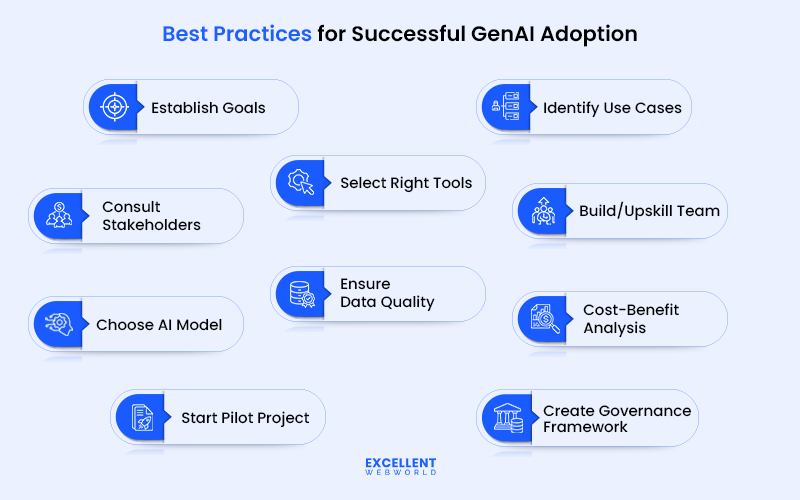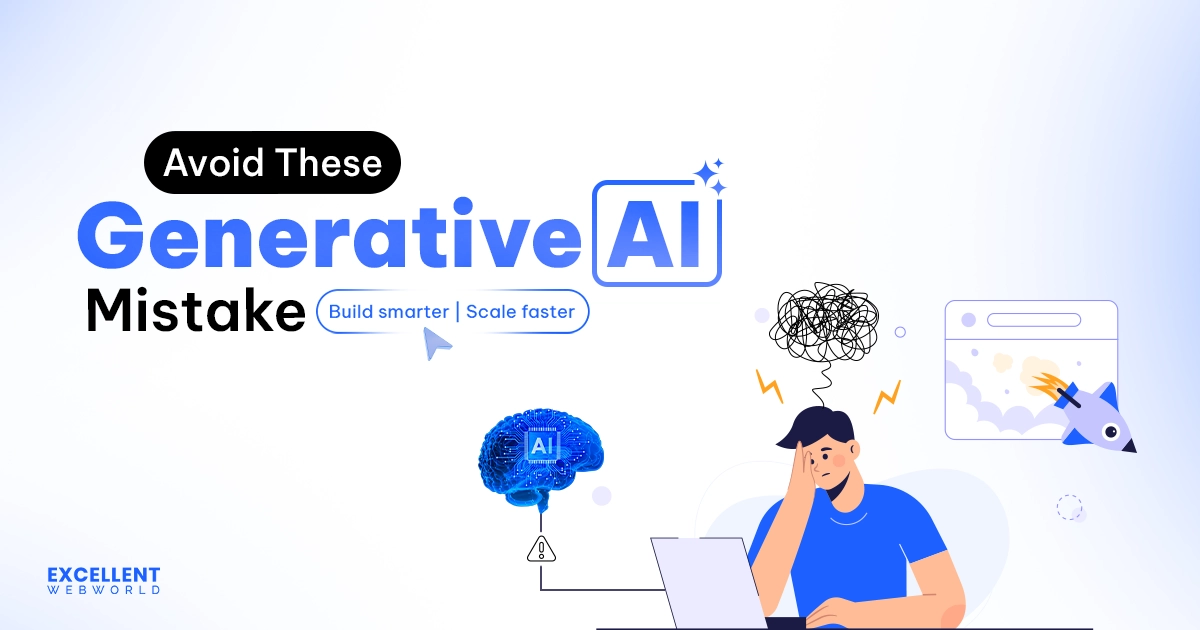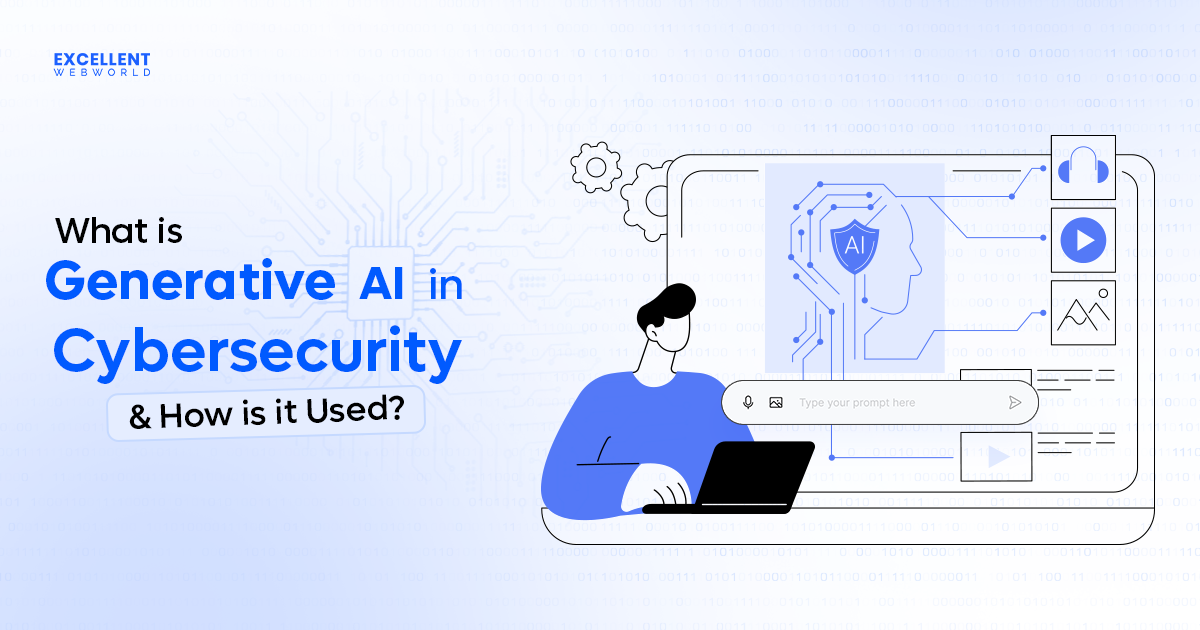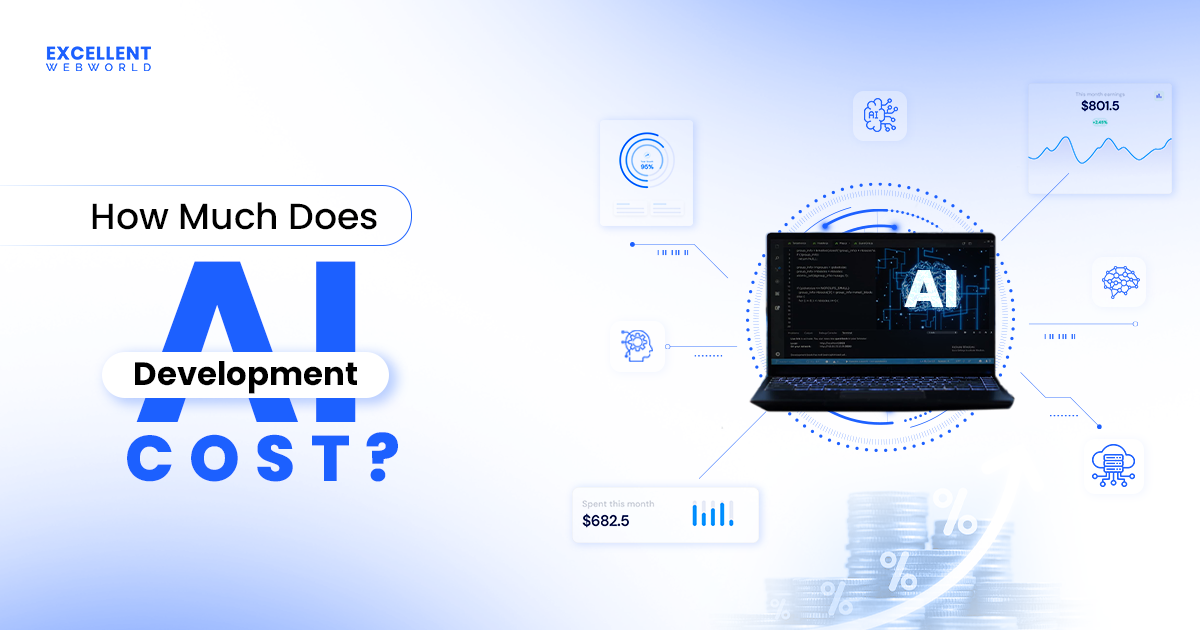Are you ready to implement generative AI but concerned about the potential pitfalls?
Wondering how to ensure your team embraces these new tools instead of resisting them?
You’re not alone, and there’s a genuine reason for this concern.
Despite the rapid adoption of generative AI, the gap between the ambition of AI integration in software development and actual results remains frustratingly wide.
Companies rush into GenAI adoption without a strategy, pick random tools, then wonder why teams resist or productivity gains never materialize.
Enterprise generative AI adoption statistics show that 43.2% of US workers now use GenAI for 1/3 of their tasks, reporting tripled productivity. (Source: SSRN)
Every generative AI adoption report highlights potential, but few show you how to integrate GenAI into your existing ecosystem successfully. That’s precisely what this guide delivers.
Based on our experience of delivering world-class GenAI solutions across industries, we’ve curated exclusive tips and best practices to help you seamlessly adopt and integrate GenAI, turning potential into measurable results.
What are the Potential Barriers and Risks Associated With the Widespread Adoption of Generative AI?
Here are the seven significant barriers to generative AI adoption in businesses you need to prepare for, each of which can disrupt or delay your AI Development Process if not addressed strategically.
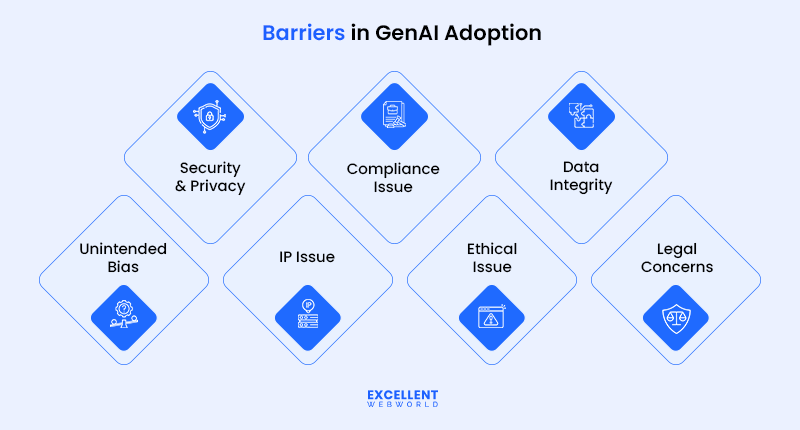
1. Unintended Bias in AI Models
Your AI models can pick up biased patterns from training data, leading to unfair selections that hurt your clients and harm your brand reputation. This creates significant business risks, primarily in areas such as hiring, lending, or customer support.
Expert Tip: Regularly test your AI outputs with diverse datasets. Set up monitoring systems to catch bias early and establish clear guidelines for your teams to review AI-generated content before it goes live.
2. Security & Privacy Considerations for AI Integration
Your sensitive enterprise data could leak through AI systems, exposing customer information or trade secrets. One of the significant generative AI adoption challenges in 2025 is protecting sensitive information while maintaining functionality. This risk is also evolving as AI itself becomes part of cybersecurity strategies, with generative AI in cybersecurity being used to detect and mitigate advanced threats.
Expert Tip: Select AI platforms that utilize strong encryption and data isolation. Never feed confidential information into public AI tools. Create data classification policies for your teams.
3. Navigating Intellectual Property in AI Deployments
Your AI-generated content might reproduce someone else’s work, putting your organization at risk of proceedings. This is especially problematic while navigating the complexity of generative AI adoption in software engineering.
Expert Tip: Use AI tools that provide source attribution. Train your developers to verify that AI-generated code doesn’t violate licenses. Consider purchasing legal insurance to protect against AI-related intellectual property (IP) risks.
4. Regulatory and Compliance Hurdles for AI Initiatives
The adoption of generative AI presents challenges in regulated industries, where AI decisions must comply with stringent regulatory requirements, such as the GDPR, HIPAA or financial regulations.
Expert Tip: Work with compliance teams early in your AI planning. Document all AI decision processes and maintain audit trails. Hire AI developers who understand your industry’s regulations.
5. Ethical Concerns in Advanced AI Adoption
As companies move toward adopting generative AI, they face questions about job displacement, fairness, and the responsible use of AI that impact employee morale and public perception.
Expert Tip: Create an AI ethics committee with diverse perspectives. Communicate transparently about AI’s role in supporting, not replacing, human workers.
6. Data Integrity in AI Systems
Poor data quality leads to unreliable AI outputs, which can damage customer relationships and inform misguided business decisions. AI implementation challenges often stem from inconsistent or outdated information.
Expert Tip: Audit your data sources before AI implementation. Establish data quality standards and regular cleanup processes to maintain accuracy.
7. Legal Concerns of Implementing Generative AI
Unclear liability when AI makes mistakes creates legal uncertainty. Who takes responsibility when your AI chatbot gives wrong advice, or an AI agent use case causes business losses?
Expert Tip: Define clear AI governance policies. Consider specialized AI liability insurance. Document human oversight processes for critical AI decisions to establish accountability.
How to Successfully Adopt GenAI in Your Business? (Best Practices and Tips)
You’re standing at the crossroads of digital transformation, knowing that adoption of Generative AI can be the game-changer your enterprise needs.
But from where do you start? How do you avoid the costly mistakes in gen AI development that have slowed down or derailed initiatives for others?
Let’s cut through the noise and provide you with a clear roadmap that actually works for your business, aligned with your goals, infrastructure, and team readiness.
1. Establish GenAI Adoption Goals
Before you dive into any GenAI task, you want clear goals. What exactly do you need to achieve? Are you trying to reduce customer support reaction times by 40%?
Write down specific, measurable goals. Avoid vague statements like “improve efficiency.” Instead, say “reduce invoice processing time from 2 days to 2 hours.”
Your goals should align with your company’s bigger picture. If your CEO is focused on cost reduction this year, frame your GenAI goals around saving money.
2. Focus On High-Value GenAI Use Cases
Don’t try to solve everything at once. The generative AI adoption curve indicates that successful companies typically begin with high-impact, low-complexity use cases.
Look for processes that are time-consuming, repetitive, done by skilled workers, and already digitized. Great starting points include customer support chatbots and content creation for marketing purposes.
Avoid complex use cases like an AI-powered lawyer consulting app until you’ve proven success with simpler applications.
3. Manage Organizational Change During AI Rollout
Your biggest challenge won’t be technology; it’ll be getting your people to embrace it. Employees often fear AI will replace them or make their jobs obsolete.
Start by identifying your champions- early adopters who are excited about AI. Train them first and let them become internal advocates.
Address concerns head-on. Show employees how AI will handle tedious tasks while they focus on strategic work.
4. Get All Stakeholders On One Page for GenAI Projects
GenAI’s success requires buy-in from IT, business users, legal, and leadership. Each group has different concerns and priorities.
Hold alignment meetings where each group can voice their concerns and gain an understanding of the perspectives of others. Create a shared vision document that addresses the needs of everyone involved.
Make sure everyone understands their role in the GenAI journey.
5. Invest In the Right GenAI Tools and Platforms
You don’t need to build everything from scratch. Today’s GenAI landscape provides powerful platforms that can be tailored to meet your specific needs.
Consider cloud-based solutions like Azure OpenAI, Amazon Bedrock, or Google Cloud AI. Focus on platforms that will grow with your needs and provide reliable support.
Evaluate platforms based on integration capabilities, security features, scalability, total cost, and vendor support.
6. Develop and Upskill Talent for GenAI Success
You need people who understand both your business and AI technology. This doesn’t mean hiring a team of PhD data scientists.
Consider training existing employees rather than hiring new ones. Your current team already understands your business processes and culture.
For specialized roles, consider hiring AI engineers who can build an AI agent or any other AI use case according to your specific needs.
7. Choose The Right Generative AI Model
Not all AI models are created equal. Build an AI model that covers your specific use cases and requirements.
Consider factors like model accuracy, response time, cost per query, data privacy features, and integration complexity.
Start with general-purpose models and fine-tune or switch to specialized models as you gain a deeper understanding of your needs.
8. Maintain High Data Quality Standards
GenAI is only as good as the data you feed it. Poor data quality leads to poor AI outputs.
Audit your data sources and clean up inconsistencies. Ensure your data is accurate, up-to-date, consistently formatted, and free from bias.
Invest in data governance processes to maintain quality over time.
9. Conduct ROI and Cost-Benefit Analysis of GenAI Investments
GenAI projects can get expensive quickly if you’re not careful. Calculate the total cost, including platform costs, infrastructure expenses, and training costs.
Compare these costs against quantifiable benefits, such as time savings, error reduction, and productivity improvements.
Include intangible benefits like improved employee satisfaction and customer experience.
10. Run Pilot Programs for Measured GenAI Adoption
Don’t roll out GenAI across your entire organization at once. Start with a small, controlled pilot project that demonstrates value.
Choose a pilot that has clear success metrics, involves motivated users, and can be completed in 2-3 months.
Use the pilot to learn, refine your approach, and build internal expertise before expanding.
11. Strengthen Data Security & Privacy Protocols
GenAI applications often handle sensitive business data. You must ensure proper security controls are in place.
Key security considerations include data encryption, access controls, audit logging, and the security practices of third-party vendors.
Work with your security team to establish GenAI-specific security policies and procedures.
12. Create an AI Governance Framework
As GenAI becomes more prevalent in your organization, you need governance structures to ensure responsible use.
This includes policies for acceptable use, data handling, model validation, risk assessment, and vendor management.
Establish clear roles and responsibilities for AI governance across your organization.
13. Prioritize Responsible AI Usage
GenAI can produce biased, incorrect, or inappropriate outputs. You need safeguards to ensure responsible use.
Build responsibility into your GenAI applications from the start, not as an afterthought. This includes output validation, bias detection, and ethical guidelines.
Regular audits and assessments help maintain responsible AI practices over time.
14. Leverage Continuous Monitoring
GenAI applications require ongoing monitoring to ensure they continue to perform as expected. Model performance can degrade over time.
Monitor key metrics like output quality, response times, user satisfaction, cost per transaction, and security incidents.
Utilize monitoring data to improve your GenAI applications continually.
15. Implement Phased Roll-Out
Once your pilot succeeds, expand GenAI adoption in phases rather than all at once. This approach enables you to learn from each phase and build upon the next.
Plan your phases based on complexity, impact, and resource availability. Focus on high-value use cases and supportive user groups first.
This phased approach enables you to manage change effectively and maintain high-quality standards.
What Industries are Currently Leading in the Adoption of Generative AI?
Healthcare and fintech companies are leading the charge in generative AI adoption by industry. Over 70% of healthcare organizations have implemented or are pursuing Generative AI capabilities, while more than 50% of financial services leaders report using generative AI in their operations.
Healthcare leaders are moving fast on generative AI, and many are already seeing results.
Two-thirds of organizations with implemented use cases report positive ROI, with even more potential ahead.
See what’s driving adoption. ➡️ https://t.co/TLl4FCBix7 pic.twitter.com/RgFF91hSKc
— McKinsey & Company (@McKinsey) April 20, 2025
Here’s what you need to know about enterprise adoption of generative AI across key sectors:
Healthcare: Doctors use AI to write patient notes faster and create treatment plans. Medical professionals utilize AI in healthcare to analyze images and automatically suggest diagnoses.
FinTech: Banks detect fraud instantly and create personalized investment advice through GenAI systems. Financial institutions utilizing AI in fintech processes can process loan applications and generate reports more efficiently.
Education: Schools utilize AI tutors that provide instant answers to students’ questions and generate personalized lesson plans tailored to each student’s needs. Educational institutions implementing AI in education automate grading for teachers.
Logistics: Companies track shipments better and predict delivery delays before they happen. Supply chain operations enhanced by AI in logistics optimize routes and manage inventory effectively.
Retail & eCommerce: Stores create personalized product recommendations and write compelling product descriptions through AI chatbots. Using AI in retail operations can help retailers improve conversion rates with smart personalisation features.
Media & Entertainment: Content creators write scripts, create music, and edit videos using generative AI tools. Studios embracing AI in entertainment streamline their creative workflows and production processes.
Automotive: Car manufacturers use AI for predictive maintenance and quality control in production. Manufacturing companies that implement AI in the automotive industry enhance defect detection and assembly optimization systems.
The generative AI adoption rate varies by industry, but early adopters consistently report improved efficiency and cost savings.
The Path Forward: Building Your GenAI Success Strategy
You now have the roadmap for generative AI enterprise adoption in 2025. But turning plans into results is hard. Your biggest problem isn’t technology; it’s finding the right partner.
At Excellent Webworld: AI-powered software development company, we help companies initiate enterprise generative AI adoption without headaches. Our AI experts help you build simple solutions that integrate seamlessly with your existing systems, delivering results quickly.
Here’s why you should choose us for generative AI adoption:
Ready to see real results? Our generative AI development company will create a customized roadmap tailored to your needs.
Book your free AI consultation today and turn GenAI into your business advantage.

Article By
Paresh Sagar is the CEO of Excellent Webworld. He firmly believes in using technology to solve challenges. His dedication and attention to detail make him an expert in helping startups in different industries digitalize their businesses globally.

